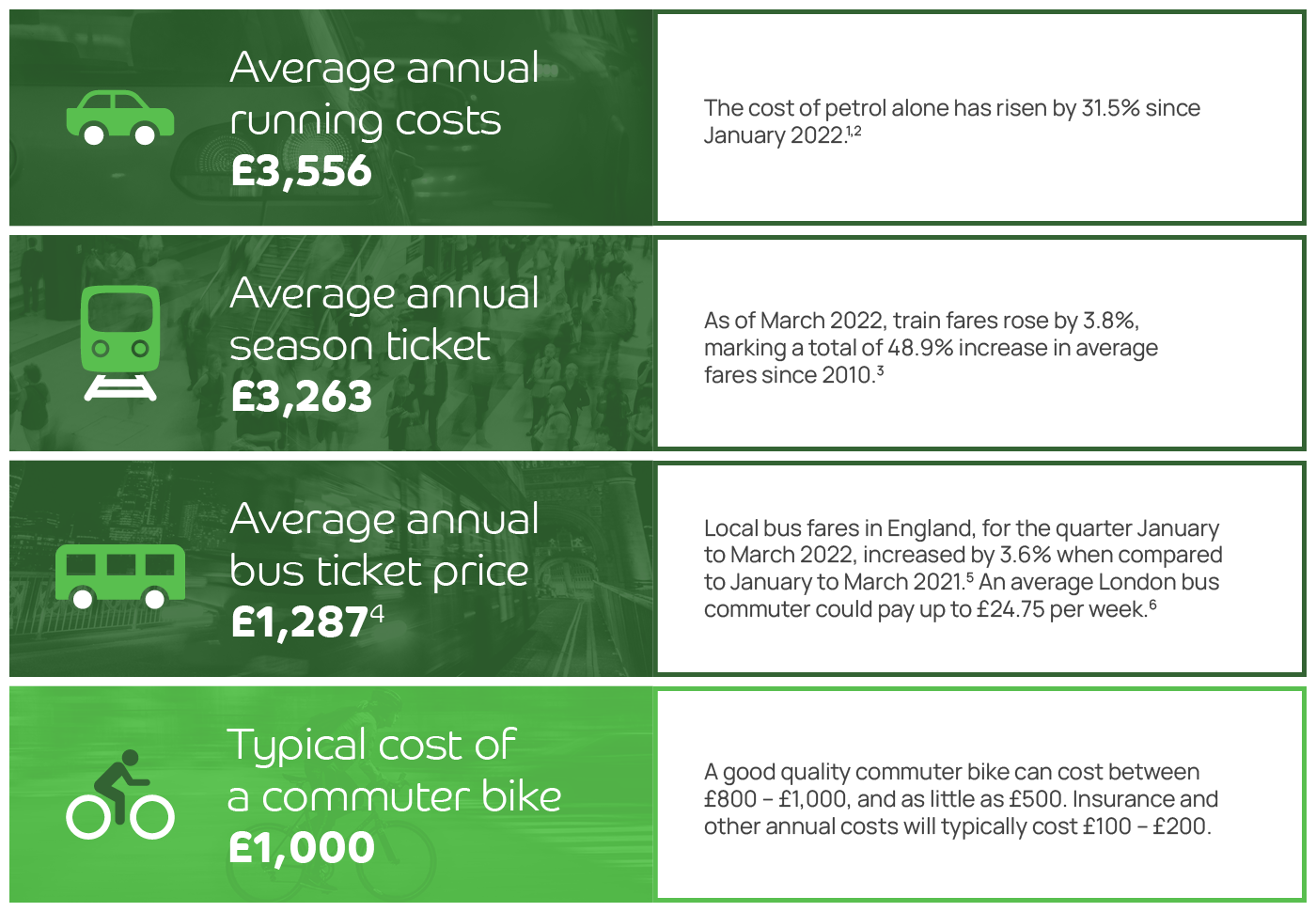Our purpose
Cycle commuting
playing its part
Tackling the cost of commuting crisis
From filling up a car to catching a train, the cost of commuting for workers is rapidly rising. Commuters need access to low cost, easy to use commuting options to help tackle these rising costs, and get a handle on one of the largest parts of the cost of living.
Cycling is the most cost effective commuting option
More than ever, commuters need access to affordable modes of transport to help them tackle the cost of living. As the cost of other travel alternatives rise, cycling is the clearest way of employees reducing their commuting costs in the long run.

1. https://www.rac.co.uk/drive/advice/fuel-watch/
2. https://www.nimblefins.co.uk/cheap-car-insurance/average-cost-run-car-uk
3. https://www.louisehaigh.org.uk/news/2022/03/01/rail-betrayal-fares-rise-twice-as-fast-as-wages-under-tories/
4. (Based on London prices) https://tfl.gov.uk/campaign/new-fares
5. https://www.gov.uk/government/statistics/quarterly-bus-statistics-january-to-march-2022/quarterly-bus-statistics-january-to-march-2022#local-bus-fares
6. https://m.stagecoachgroup.com/media/news-releases/2020/2020-02-13.aspx
Cycling is a far lower cost commuting option than car or rail, offering significant savings for a high quality bike. In the face of spiralling expenses, cycling offers a route to reducing costs and putting money back in peoples’ pockets.
The Cycle to Work scheme makes cycling even more cost effective
By using the Cycle to Work scheme, employees are able to reduce the cost of commuting even further.
Through the scheme, employees can spread the costs out over many months and thereby help employees to obtain a high quality bike or e-bike.
A basic rate taxpayer will typically save 43% on the cost of a bike. This saving also extends to any equipment obtained with the bike, such as a helmet, a lock and lights. Furthermore, unlike some other options, the scheme enables users to pay the cost off typically over 12 months, making it even more affordable.
43% of scheme users state that the main reason why they were encouraged to join was because it spread the cost of a bike and cycling equipment over several months.

Not only does the Cycle to Work scheme save consumers money and allow them to spread payments out, it also does not come with the same risks as credit cards or buy now pay later schemes. As a salary sacrifice, consumers are not at the same risk of late payment fees, high interest rates or bad credit scores. So long as an employer offers the scheme and certain conditions are met, employees can obtain access to a bike and start their cycle commuting.
Helping all employees with the cost of commuting
The way the scheme is currently designed means that some employees – particularly those on low incomes or self-employed – are unable to access the scheme to obtain a bike. This excludes some employees that would benefit most from a low cost commuting option.
A third of employees who had not previously participated in the scheme said this was because their income was too low, which prevented them from participating because of current National Minimum Wage rules. A further 1 in 10 of these said it was because they were self-employed, meaning they could not access the scheme.
The Alliance has called on government to improve accessibility to the scheme alongside the FSB, Co-Op and other cycling and business groups to make cycling to work more accessible for all employees.
This is more important than ever as the cost of commuting crisis bites and employees need cheaper ways of commuting to work. The Cycle to Work scheme is a clear solution that many employees are locked out from accessing.
Government should announce plans to make cycle commuting and the scheme’s savings accessible to all as part of its upcoming Budget.
